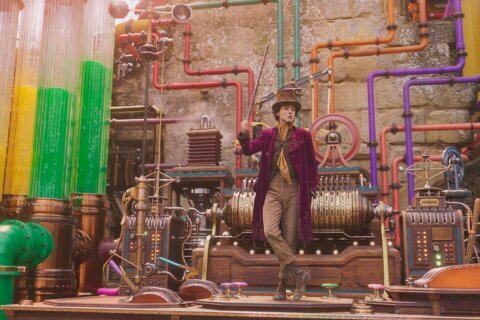One of the most stirring and resonant sequences in a film this awards season comes from an unlikely source: “Puss in Boots: The Last Wish.”
The DreamWorks film, a sequel to a spinoff of “Shrek,” follows the titular feline as he attempts to restore eight of the nine lives he’s spent. He spends most of the film committing acts of daring with panache and charm to spare, as audiences have come to expect from Puss in Boots.
But during one crucial sequence, Puss loses faith, and panic and fear threaten to consume him.
Puss slumps against a tree in a forest, huffing and puffing. His rapid heartbeat drowns out any other sound in the forest where he lies. His friend, the affable therapy dog Perrito, notices Puss is in distress and lays his head on our feline hero’s tummy. Puss exhales a few times, calmly pets Perrito and is able to recover.
It’s a quiet, brief moment in an otherwise jovial film aimed at young viewers and families. But it’s resonating with many viewers for its depiction of what it feels like to have a panic attack — and the relief of coming out the other side.
“That was one of our big goals — let’s take our audience on a journey that expresses the full range of emotions of life,” said Joel Crawford, director of “Puss in Boots: The Last Wish,” in an interview with CNN.
There are still hard-won victories, gags and hard-earned wisdom in the film, but what lends “Puss in Boots: The Last Wish” its staying power is its heart and honesty, even in a fairy-tale setting. Psychologists spoke with CNN about why it can be impactful to see panic attacks reflected on screen — and how a bipedal, sword-carrying cat got it right.
What a panic attack can feel like
A panic attack is “basically a wave of powerful, physical fear that feels overwhelming,” said David Carbonell, a clinical psychologist based in Chicago who specializes in fear and phobias. Someone experiencing a panic attack may feel their heart beating at a faster-than-normal rate and have trouble catching their breath. Lightheadedness and tingles in extremities are common, too. But the throughline is always fear that feels suffocating, even if that fear doesn’t match one’s circumstances.
Lynn Bufka, associate chief of practice transformation at the American Psychological Association and a clinician, compared a panic attack to an encounter in the desert with a terrifying rattlesnake. Faced with a venomous foe, our body would trigger a physiological response to the fear in front of us. But with a panic attack, there usually isn’t an obvious cause, and this unknown element can make a panic attack feel even scarier, she said.
How ‘Puss in Boots’ brought a panic attack to life
“Puss in Boots: The Last Wish” takes place in the same fairy-tale land of the “Shrek” series, with its anthropomorphic animals and ogres with hearts of gold. The new film features Goldilocks and the three bears, a grown-up and villainous version of “Little Jack Horner” of nursery rhyme fame and Salma Hayek as a feline foil to Antonio Banderas’ Puss in Boots. All of them are after a mythical wishing star, which, if Puss can reach it first, could restore the first eight of his nine lives.
It’s all very fantastical and humorous until it isn’t. In a brief but crucial sequence, Puss is overwhelmed by fear and can’t catch his breath. Even his comedic sidekick Perrito straightens up to calmly comfort Puss. It’s a sober moment in an otherwise jovial story.
That was intentional, director Crawford said. He told CNN that the moment wasn’t for laughs, and the film as a whole aimed to portray a more vulnerable side to the swashbuckling cat audiences have come to know.
“(Watching) an animated world is such a great way to escape,” he said, while noting that challenging topics can be explored through the comfort of fiction.
The process began with the film’s screenwriters, Paul Fisher and Tommy Swerdlow, who brought their own experiences to the film’s portrayal of fear and panic, as well as Crawford and co-director Januel Mercado. Then it moved to storyboard artist Taylor Meacham, who drew from his own panic attacks to sketch what Puss might look like. Everything from the “tunnel vision” when viewers see Puss’ point of view to the loud heartbeat that takes over the scene were pulled from his experiences with panic, Meacham told CNN.
He also made sure the scene slowed down to take the time “needed for Puss in Boots to relax and breathe as he comes out of his attack,” he said. “The contrast from such intensity gradually into calm is another moment I hope feels real for viewers.”
Animator Prashanth Cavale even filmed himself as a reference for the scene, adding “tiny clenches and twitches” to add a lifelike texture to the scene, Cavale told CNN.
The goal, Crawford said, was to avoid making the moment feel “superficial or forced” while keeping it accessible to viewers of all ages.
“Fear, weakness, anxiety — if anybody has ever felt those emotions, which is everybody, we wanted to make sure this scene related to them,” Crawford said.
Why the scene works, according to psychologists
What audiences see in “Puss in Boots: The Last Wish” is less what a panic attack looks like to a bystander and more what it feels like to have one. A panic attack is often imperceptible to everyone except the person experiencing them, Bufka and Carbonell said. But in the moment, a panic attack can feel like a catastrophic event, even if it doesn’t look like one on the outside.
“Puss in Boots” isn’t the first example of popular media to feature a character experiencing a panic attack. Tony Soprano infamously suffered from them in “The Sopranos,” though his were greatly exaggerated and unrealistic — it’s rare for people to collapse during or after a panic attack, Carbonell said. The new HBO Max series “Velma” takes a heightened approach to panic attacks, too, showing both its bespectacled protagonist’s exaggerated perspective of panic and the subdued reality. (HBO and CNN share parent company Warner Bros. Discovery.)
Former ABC News journalist Dan Harris even had a panic attack live on air while reading a brief news item, though most coworkers and viewers didn’t know it at the time thanks to his outwardly calm demeanor.
Even if a panic attack portrayed onscreen isn’t a universal representation of the psychological phenomenon, seeing a character have one, particularly in a film like “Puss in Boots” that children and adults alike will view, can lead someone to consider their own experiences with panic and anxiety and seek help from an expert or from loved ones, Bufka said.
“It just really helps to normalize that this happens, and that you can recover,” she said.
When Puss finds comfort in his friend, the portly Perrito, who lends a paw for support without saying anything, the dog’s response is a fine example for people to follow if they know their loved ones have panic attacks, Carbonell said.
“You want to undercut the panic and bring it back down to reasonable proportions,” Carbonell said. Simply being there for someone and not overwhelming them with suggestions can help ground them.
Puss also accepts the help Perrito silently offers him. Fighting against a panic attack, Carbonell said, can often elongate and worsen it — the “quicksand of mental illness.” But letting it pass and rediscovering one’s calm is often the quickest way to get through it, he said.
For children, especially, seeing a character feel extreme fear and then find comfort in a loved one can be impactful, Bufka said, even if they’re not familiar with the term “panic attack.”
“People don’t always have the language for their emotions,” she said. “But it’s important to have it onscreen, because it helps people feel seen, recognized and not alone.”
The-CNN-Wire
™ & © 2023 Cable News Network, Inc., a Warner Bros. Discovery Company. All rights reserved.







